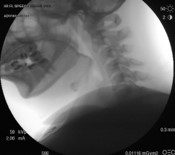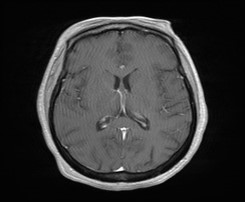Monday Poster Session
Category: Diet, Nutrition, and Obesity
P2718 - Exploring the Link Between Functional Dysphagia and Wernicke's Encephalopathy
Monday, October 27, 2025
10:30 AM - 4:00 PM PDT
Location: Exhibit Hall

Haniya Waseem, MD (she/her/hers)
AdventHealth
Tampa, FL
Presenting Author(s)
Haniya Waseem, MD, FNU Naina, MD, Sagar Patil, MD
AdventHealth, Tampa, FL
Introduction: Functional dysphagia, is characterized by the sensation of food sticking or delay in food passage through the esophagus, as defined by the Rome criteria. Wernicke's encephalopathy is a degenerative brain disorder caused by thiamine (vitamin B1) deficiency, presenting acutely with the classic triad of ophthalmoplegia, ataxia, and confusion. We report a case of Wernicke's encephalopathy in a nonalcoholic patient with functional dysphagia.
Case Description/
Methods: A 34-year-old female presented to the emergency department with altered mental status, which began two days prior. Her family reported that she had not been acting like herself and had experienced significant weight loss of over 25 lbs in the past three months due to poor oral intake secondary to dysphagia.
Ten days prior, she was evaluated in the hospital for dysphagia and odynophagia, at which time she underwent an esophagogastroduodenoscopy (EGD) with empiric 51 Fr dilation. Biopsies taken during the procedure were negative for eosinophilic esophagitis or Helicobacter pylori infection. A modified barium swallow study revealed no evidence of oral or pharyngeal dysphagia. Additionally, a repeat EGD and a CT scan of the neck showed no obstructive pathology.
MRI of the brain with IV contrast revealed abnormal FLAIR signal in the medial thalami, periaqueductal region, and tectal plate in a symmetric pattern, suggestive of metabolic or toxic abnormalities, most notably thiamine deficiency, Wernicke’s encephalopathy, or West Nile virus infection. However, cerebrospinal fluid (CSF) analysis was negative for bacterial, viral, or autoimmune etiologies. Laboratory workup revealed low plasma thiamine levels.
Given her vision changes, confusion, ataxia, and prolonged history of dysphagia leading to poor dietary intake and weight loss, Wernicke’s encephalopathy was diagnosed. She was started on IV thiamine for three days, followed by oral thiamine supplementation. Her ocular abnormalities and gait ataxia improved; however, dysphagia persisted despite treatment
Discussion:

Figure: Fig 1. XR FL Swallow study

Figure: Fig 2. unenhanced brain MRI there is abnormal FLAIR signal in a bilaterally symmetric fashion involving the medial thalami and extending towards the mamillary bodies. There is also circumferential abnormal FLAIR signal in the periaqueductal region. There is abnormal FLAIR signal within the tectal plate.
Disclosures:
Haniya Waseem indicated no relevant financial relationships.
FNU Naina indicated no relevant financial relationships.
Sagar Patil indicated no relevant financial relationships.
Haniya Waseem, MD, FNU Naina, MD, Sagar Patil, MD. P2718 - Exploring the Link Between Functional Dysphagia and Wernicke's Encephalopathy, ACG 2025 Annual Scientific Meeting Abstracts. Phoenix, AZ: American College of Gastroenterology.
AdventHealth, Tampa, FL
Introduction: Functional dysphagia, is characterized by the sensation of food sticking or delay in food passage through the esophagus, as defined by the Rome criteria. Wernicke's encephalopathy is a degenerative brain disorder caused by thiamine (vitamin B1) deficiency, presenting acutely with the classic triad of ophthalmoplegia, ataxia, and confusion. We report a case of Wernicke's encephalopathy in a nonalcoholic patient with functional dysphagia.
Case Description/
Methods: A 34-year-old female presented to the emergency department with altered mental status, which began two days prior. Her family reported that she had not been acting like herself and had experienced significant weight loss of over 25 lbs in the past three months due to poor oral intake secondary to dysphagia.
Ten days prior, she was evaluated in the hospital for dysphagia and odynophagia, at which time she underwent an esophagogastroduodenoscopy (EGD) with empiric 51 Fr dilation. Biopsies taken during the procedure were negative for eosinophilic esophagitis or Helicobacter pylori infection. A modified barium swallow study revealed no evidence of oral or pharyngeal dysphagia. Additionally, a repeat EGD and a CT scan of the neck showed no obstructive pathology.
MRI of the brain with IV contrast revealed abnormal FLAIR signal in the medial thalami, periaqueductal region, and tectal plate in a symmetric pattern, suggestive of metabolic or toxic abnormalities, most notably thiamine deficiency, Wernicke’s encephalopathy, or West Nile virus infection. However, cerebrospinal fluid (CSF) analysis was negative for bacterial, viral, or autoimmune etiologies. Laboratory workup revealed low plasma thiamine levels.
Given her vision changes, confusion, ataxia, and prolonged history of dysphagia leading to poor dietary intake and weight loss, Wernicke’s encephalopathy was diagnosed. She was started on IV thiamine for three days, followed by oral thiamine supplementation. Her ocular abnormalities and gait ataxia improved; however, dysphagia persisted despite treatment
Discussion:

Figure: Fig 1. XR FL Swallow study

Figure: Fig 2. unenhanced brain MRI there is abnormal FLAIR signal in a bilaterally symmetric fashion involving the medial thalami and extending towards the mamillary bodies. There is also circumferential abnormal FLAIR signal in the periaqueductal region. There is abnormal FLAIR signal within the tectal plate.
Disclosures:
Haniya Waseem indicated no relevant financial relationships.
FNU Naina indicated no relevant financial relationships.
Sagar Patil indicated no relevant financial relationships.
Haniya Waseem, MD, FNU Naina, MD, Sagar Patil, MD. P2718 - Exploring the Link Between Functional Dysphagia and Wernicke's Encephalopathy, ACG 2025 Annual Scientific Meeting Abstracts. Phoenix, AZ: American College of Gastroenterology.
